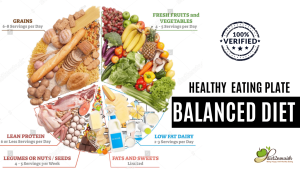A balanced diet chart is a helpful tool to ensure that you are consuming a variety of nutrient-rich foods in appropriate portions to meet your body’s needs. In this 500-word paragraph, we will discuss how to prepare a balanced diet chart that meets your individual needs and preferences.
Step 1: Determine your daily calorie needs The first step in preparing a balanced diet chart is to determine your daily calorie needs. This can be done by using an online calculator or consulting with a registered dietitian. Your calorie needs will depend on factors such as age, gender, height, weight, and activity level.
Step 2: Choose your food groups Once you know your daily calorie needs, you can start choosing foods from each food group. The five food groups include fruits, vegetables, grains, proteins, and dairy. Aim to fill half of your plate with fruits and vegetables, one quarter with whole grains, and one quarter with lean proteins. Include low-fat dairy products in your diet as well.
Step 3: Determine portion sizes Portion sizes are important to ensure that you are not consuming too many or too few calories. Use a food scale or measuring cups and spoons to determine portion sizes. For example, a serving of fruit is one medium-sized fruit, a half-cup of canned or frozen fruit, or one-fourth cup of dried fruit.
Step 4: Plan your meals and snacks Planning your meals and snacks in advance can help you stay on track with your balanced diet. Aim to eat three meals and one or two snacks per day. Include a variety of foods from each food group in your meals and snacks.
Here is an example of a balanced diet chart for a 2000-calorie diet:
Breakfast:
- 2 scrambled eggs
- 1 slice whole-grain toast
- 1 small banana
- 1 cup low-fat milk
Morning snack:
- 1 small apple
- 1 oz almonds
Lunch:
- Grilled chicken breast
- 1 cup cooked brown rice
- 1 cup steamed vegetables
- 1 small whole-grain roll
- 1 cup low-fat yogurt
Afternoon snack:
- 1 medium orange
- 1 oz cheese
Dinner:
- Baked salmon fillet
- 1 cup roasted sweet potatoes
- 1 cup steamed broccoli
- 1 small whole-grain roll
- 1 cup low-fat milk
Dessert:
- 1 small slice of angel food cake
- 1 cup mixed berries
It’s important to note that this is just an example, and a balanced diet chart may look different for each individual. The key is to include a variety of nutrient-rich foods from each food group and to limit consumption of processed and high-fat foods.
In conclusion, preparing a balanced diet chart is a helpful tool to ensure that you are consuming a variety of nutrient-rich foods in appropriate portions to meet your body’s needs. By determining your daily calorie needs, choosing foods from each food group, determining portion sizes, and planning your meals and snacks, you can achieve a balanced diet that meets your individual needs and preferences. Consulting with a registered dietitian can also be helpful in creating a personalized meal plan.
